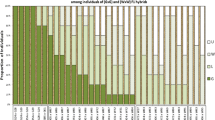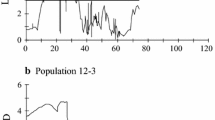Abstract
Studies of the breeding behavior of clones containing high levels of anthocyanins were conducted. Red-fleshed clones appeared in proportions suggesting multigenic control of degree of pigmentation. Red-fleshed and pur-ple-fleshed clones were always accompanied by red and purple skin, respectively. Red flesh ranged from partial pigmentation to complete pigmentation represented by pigment present in all tuber tissues. Percentage of com-pletely red-fleshed progeny was 14.5% and 4.1% in red x red crosses vs red × white (or the reciprocal), respectively. Purple-fleshed progeny were obtained from red x white crosses where the white-fleshed parent harbored theP pigment gene in juxtaposition with the nulliplex recessive state of theI gene (i.e.,iiii), which suppressed expression. Total anthocyanin ranged from 6.9 to 35 mg per 100 g fresh weight in the red-fleshed and 5.5 to 17.1 in the purple-fleshed clones. Red-fleshed clones contained predominantly acylated glycosides of pelargonidin while the purple-fleshed clones contained predominantly acylated glycosides of petunidin and peonidin. Oxygen Radical Absorbance Capacity and Ferrous Reducing Ability of Plasma revealed that the antioxidant levels in the red or purple-fleshed potatoes were two to three times higher than white-fleshed potato.
Resumen
Se llevaron a cabo estudios de mejoramiento sobre el comportamiento de clones de papa con niveles altos de antocianinas. Los clones de pulpa roja mostraron esta característica en mayor proporción, lo que sugiere un control multigénico del grado de pigmentación. Los clones de pulpa roja y los de pulpa morada estuvieron siempre acompañados de piel roja y piel morada respectivamente. La pulpa roja varió desde una pigmentación parcial a una pigmentación completa, en el cual el pigmento se encontraba presente en todos los tejidos del tubérculo. El porcentaje en una progenie de pulpa roja completa fue de 14.5% y 4.1% en los cruzamientos rojo x rojo vs. rojo × bianco (o recíproco) respectivamente. La progenie de pulpa morada se obtuvo de cruzamientos rojo × blanco, donde el progenitor de pulpa blanca albergaba el gen del pigmento moradoP en yuxtaposición con el estado recesivo nuliplex del gen inhibidorI, el cual suprimió la expresión. La antocianina total varió de 6.9 a 35mg por 100g de peso fresco en los clones de pulpa roja y de 5.5 a 17.1 mg en los de pulpa morada. Los clones de pulpa roja contenían predominantemente glicósidos acilados de pelargonidina, mientras que los clones morados contenían predominantemente glicósidos acilados de petunidina y pelargonidina. La Capacidad de Absorbencia del Radical Oxigeno y la Habilidad del Plasma para la Reducción del Hierro revelaron que los niveles de antioxidante en papas de pulpa roja o morada fueron de dos a tres veces mayores que en las papas de pulpa blanca.
Similar content being viewed by others
Literature Cited
Benzie IFF, and JJ Strain. 1996. The ferric reducing ability of plasma (FRAP) as a measure of “antioxidant power”: the FRAP assay. Anal Biochem 239:70–76.
Cao G, HMM Alessio, and RG Cutler. 1993. Oxygen-radical absorbance capacity for antioxidants. Free Rad Biol Med 14:303–311.
Cao G, and RL Prior. 1998. Comparison of different analytical methods for assessing total antioxidant capacity of human serum. Clin Chemistry 44:1309–1315.
Cao G, RM Russell, N Lischner, and RL Prior. 1998. Serum antioxidant capacity is increased by consumption of strawberries, spinach, red wine or vitamin C in elderly women. J Nutr 128:2383–2390.
Cao G, B Shukitt-Hale, PC Bickford, JA Joseph, J McEwen, and RL Prior. 1999. Hyperoxia-induced changes in antioxidant capacity and the effect of dietary antioxidants. J Appl Physiol 86:1817–1822.
Cao G, CP Verdon, AHB Wu, H Wang, and RL Prior. 1995. Automated oxygen radical absorbance capacity assay using the COBAS FARA II. Clin Chem 41:1738–1744.
De Jong H. 1991. Inheritance of anthocyanin pigmentation in the cultij vated potato: a critical review. Am Potato J 68:585–593.
De Jong H. 1987. Inheritance of pigmented tuber flesh in cultivated diploid potatoes. Am Potato J 64:337–343.
Dodds KS, and DH Long. 1955. The inheritance of colour in diploid potatoes: types of anthocyanidins and their genetic loci. J Genetics 53:136–149.
Dodds KS, and DH Long. 1956. The inheritance of colour in diploid potatoes: II. A three-factor linkage group. J Genetics 54:2741.
Durst RW, and R Wrolstad. 2001. Separation and characterization of anthocyanins by HPLC.In: RE Wrolstad (ed), Current Protocols in Food Analytical Chemistry. John Wiley & Sons, New York. Unit 1.3.1–13.
Gebhardt C, E Ritter, T Debener, U Schnachtschabel, B Walkemeier, H Uhrig, and F Salamini. 1989. RFLP analysis and linkage mapping inSolanum tuberosum. Theor Appl Genet 78:65–75.
Giusti MM, and RE Wrolstad. 1996. Characterization of red radish anthocyanins. J Food Sci 61(2):322–326.
Giusti MM, and RE Wrolstad. 2001. Anthocyanins: Characterization and measurement with UV-visible spectroscopy.In: RE Wrolstad (ed), Current Protocols in Food Analytical Chemistry. John Wiley & Sons, New York. Unit F1.2.1–13.
Harbourne JB. 1960. Plant polyphenols: I. Anthocyanin production in the cultivated potato. Biochem J 74:262–269.
Hertog MGL, E Feskens, P Hollman, M Katan, and D Kromhout. 1993. Dietary antioxidant flavonoids and risk of coronary heart disease: the Zutphen elderly study. Lancet 342:1007–1011.
Knekt P, R Jarvinen, A Reunanen, and J Maatela. 1996. Flavonoid intake and coronary mortality in Finland: a cohort study. Brit Med J 312:478–481.
Kruezer H. 2001. Incorporating lutein into foods and beverages. Suppl Food Prod Design 11(4) 5 p.
Lunden AP. 1960. Some more evidence of autotetraploid inheritance in the potato (Solanum tuberosum). Euphytica 9:225–234.
Plaisted RL. 1980. Potato.In: WR Fehr and HH Hadley (eds), Hybridization of Crop Plants. American Society of Agronomy, Madison, WI. pp. 483–492.
Rodriguez-Saona LE, MM Giusti, and RE Wrolstad. 1998. Anthocyanin pigment composition of red-fleshed potatoes. J Food Sci 63: 458–465.
Swaminathan MS, and HW Howard. 1953. The cytology and genetics of the potato (Solanum tuberosum) and related species. Bibliographia Genet 16(1)
Van Eck HJ, JME Jacobs, PMMM Van den Berg, WJ Stiekema, and E Jacobsen. 1994. The inheritance of anthocyanin pigmentation in potato (Solanum tuberosum L.) and mapping of tuber skin colour using RFLP’s. Heredity 73:410421.
Wang H, MG Nair, GM Strasburg, YC Chang, AM Booren, JI Gray, and DL De Witt. 1999. Antioxidant and anti-inflammatory activities of anthocyanins and their aglycon, cyanidin, from tartcherries. J Nat Prod 62:294–296.
Author information
Authors and Affiliations
Corresponding author
Rights and permissions
About this article
Cite this article
Brown, C.R., Wrolstad, R., Durst, R. et al. Breeding studies in potatoes containing high concentrations of anthocyanins. Am. J. Pot Res 80, 241–249 (2003). https://doi.org/10.1007/BF02855360
Accepted:
Issue Date:
DOI: https://doi.org/10.1007/BF02855360




